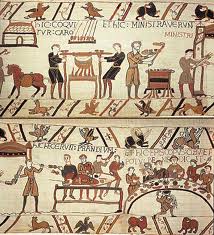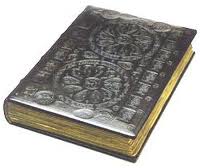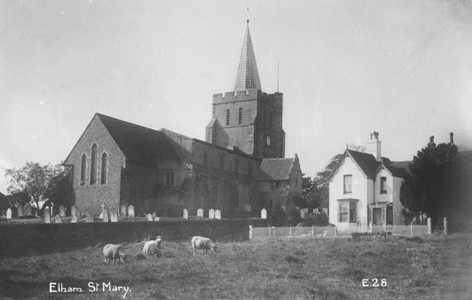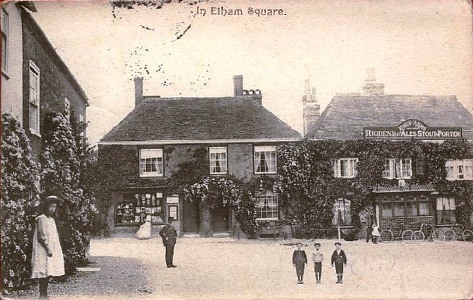| | | | | |
| |
1060:
|
Edric of Elham
.
EDRIC [* OF ELHAM *]. Edric of Elham is named as predecessor of the bishop of Bayeux at Ewell and Tickenhurst in Kent, and is almost certainly the Edric who preceded him on the very valuable manor of Elham itself . There is little reason to doubt that he is the Edric who preceded the bishop on other manors in the county since these, too, were valuable and the few other Edrics in the county have associations with the bishop and are probably the same man. Edric's Canterbury manor of Garrington was previously held by the bishop of Bayeux , and those Hugh de Montfort acquired from Edric at Newington and Ewell were part of manors he held as a tenant of the bishop . Dr Williams suggests he 'perhaps' held Solton , which follows Ewell and West Cliffe and where no pre-Conquest lord is named: World before Domesday, pp. 49, 172-73 and notes 28-30. The manor was valued at £15 in 1066; but the valuation is so disproportionate to the manor's resources that a scribal error for 15 shillings seems likely. The identity of the one remaining Edric, on a modest property at 'Stokenbury' , is less certain; but even here there is an indirect association with Odo: Domesday Monachorum, p. 94. Edric may also have held the valuable manor of Dorking in Surrey , where the bishop of Bayeux had an interest; this Edric is one of two in the county, the only one of substance. Dorking was 'held' by Queen Edith, so Edric was her man or may have preceded or succeeded her, in which latter case he survived the Conquest by a decade; but the text of the entry is ambiguous. There are similar high-status manors held by Edrics in Berkshire and Hampshire, but no tenurial associations to connect them to Edric of Elham. A list of his manors is given by Clarke, English nobility, pp. 304-305, which does not include 'Stokenbury', Dorking or Solton. Dr Clarke ranks him fifty-sixth in wealth among untitled laymen; the addition of Dorking would place him comfortably among the top forty.
edocs.hull.ac.uk
|
| |
1066:
|
William I
.
(c 1027 - 1087) House of Normandy. Defeated King Harold Godwinson at Hastings. Also known as William the Conqueror (French: Guillaume le Conquérant) and William II of Normandy (Guillaume II de Normandie). First Norman King of England.
|
| |
1067:
|
 Odo of Bayeaux
.
He was the son of William the Conqueror's mother Herleva, and Herluin de Conteville. Although he was an ordained Christian cleric, he is best known as a warrior and statesman. He found ships for the invasion of England and is one of the very few proven Companions of William the Conqueror known to have fought at the Battle of Hastings in 1066. The Bayeux Tapestry, probably commissioned by him to adorn his own cathedral, appears to labour the point that he did not actually fight, that is to say shed blood, at Hastings, but rather encouraged the troops from the rear. The Latin annotation embroidered onto the Tapestry above his image reads: "Hic Odo Eps (Episcopus) Baculu(m) Tenens Confortat Pueros", in English "Here Odo the Bishop holding a club strengthens the boys". It seems that his clerical status forbade him from using a sword. He was accompanied by William the carrier of his crozier and a retinue of servants and members of his household. In 1067 Odo became earl of Kent, and for some years he was a trusted royal minister. On some occasions when William was absent (back in Normandy), he served as de facto regent of England, and at times he led the royal forces against rebellions (e.g. the Revolt of the Earls): the precise sphere of his powers is not certain, however. There are also other occasions when he accompanied William back to Normandy. During this time Odo acquired vast estates in England, larger in extent than any one except the king: he had land in 23 counties, primarily in the south east and in East Anglia.
Odo of Bayeaux
.
He was the son of William the Conqueror's mother Herleva, and Herluin de Conteville. Although he was an ordained Christian cleric, he is best known as a warrior and statesman. He found ships for the invasion of England and is one of the very few proven Companions of William the Conqueror known to have fought at the Battle of Hastings in 1066. The Bayeux Tapestry, probably commissioned by him to adorn his own cathedral, appears to labour the point that he did not actually fight, that is to say shed blood, at Hastings, but rather encouraged the troops from the rear. The Latin annotation embroidered onto the Tapestry above his image reads: "Hic Odo Eps (Episcopus) Baculu(m) Tenens Confortat Pueros", in English "Here Odo the Bishop holding a club strengthens the boys". It seems that his clerical status forbade him from using a sword. He was accompanied by William the carrier of his crozier and a retinue of servants and members of his household. In 1067 Odo became earl of Kent, and for some years he was a trusted royal minister. On some occasions when William was absent (back in Normandy), he served as de facto regent of England, and at times he led the royal forces against rebellions (e.g. the Revolt of the Earls): the precise sphere of his powers is not certain, however. There are also other occasions when he accompanied William back to Normandy. During this time Odo acquired vast estates in England, larger in extent than any one except the king: he had land in 23 counties, primarily in the south east and in East Anglia. In 1076 Odo was tried in front of a large and senior assembly over the course of three days at Penenden Heath in Kent for defrauding the Crown and the Diocese of Canterbury. At the conclusion of the trial he was forced to return a number of properties and his assets were re-apportioned. In 1082 he was suddenly disgraced and imprisoned for having planned a military expedition to Italy. His motivations are not certain. Chroniclers writing a generation later said Odo desired to make himself Pope, but the contemporary evidence is ambiguous. Whatever the reason, Odo spent the next five years in prison, and his English estates were taken back by the king, as was his office as Earl of Kent: Odo was not however deposed as Bishop of Bayeux. William, on his deathbed in 1087, was reluctantly persuaded by his brother Robert, Count of Mortain to release Odo. After the king's death Odo returned to his earldom and soon organized a rebellion in support of William's son Robert Curthose, who had been made Duke of Normandy. The Rebellion of 1088 failed and William Rufus permitted Odo to leave the kingdom. Afterwards, Odo remained in the service of Robert in Normandy. He joined the First Crusade, and started in the duke's company for Palestine, but died on the way at Palermo in January or February 1097. Little good is recorded of Odo. It was recorded that his vast wealth was gained by extortion and robbery. His ambitions were boundless and his morals lax. However, like many prelates of his age, he was a patron of learning and the arts. He was also a great architect. He founded the Abbaye de Troarn in 1059 and rebuilt the cathedral of his see, and is likely to have commissioned the celebrated Bayeux tapestry. He may also have sponsored an early version of The Song of Roland. More certain is his development of the cathedral school in Bayeux, and his patronage of a number of younger men who later became prominent prelates.
Wikipedia
|
| |
1086:
|
 Domesday Book
.
The Domesday Book was commissioned in December 1085 by William the Conqueror - who invaded England in 1066. The first draft was completed in August 1086 and contained records for 13418 settlements in the English counties south of the rivers Ribble and Tees (the border with Scotland at the time). The first written history of Elham is contained in this book.
Domesday Book
.
The Domesday Book was commissioned in December 1085 by William the Conqueror - who invaded England in 1066. The first draft was completed in August 1086 and contained records for 13418 settlements in the English counties south of the rivers Ribble and Tees (the border with Scotland at the time). The first written history of Elham is contained in this book.
|
| |
1086:
|
William d'Aubigny II
.
He accompanied William the Conqueror into England, and acquired extensive territorial possessions by royal grants in Norfolk and other counties. Of these grants was the lordship of Bokenham, to be held by the service of being Butler to the Kings of England on the day of their coronation, and in consequence we find this William styled in divers charters "Pincerna Henrici Regis Anglorum." William de Albini founded the Abbey of Wymondham in Norfolk. William de Albini also gave to the monks of Rochester the tithes of his manor of Elham; as also one carucate of land in Achestede, with a wood called Acholte. He likewise bestowed upon the Abbey of St. Etienne at Caen, in Normandy, all his lands lying in Stavell, which grant he made in the presence of King Henry and his barons. He married Maud Bigod, daughter of Roger Bigod, with whom he obtained ten knight's fees in Norfolk.
|
| |
1087:
|
|
| |
1100:
|
|
| |
1135:
|
|
| |
1141:
|
Empress Matilda (Queen Maud)
.
|
| |
1154:
|
|
| c |
1180:
|
 Church of St Mary the Virgin
.
This is an exceptionally fine village church, built of flint rubble and ragstone, and dating from about 1180.
It has good lancet windows, and later Decorated work. There were many alterations and additions during the 15th century, and these include the clerestory, the aisle windows, and the north chancel chapet. The church is, however especially noteworthy for the superb quality of its furnishings, a number of which were the gift of a former vicar, the Rev. Alard Charles de Bourbel, B.O., (1900-1935), with other items contributed by the Rev. Robert Henry lsaac Williams, M.A., (1935-1957), and others of the parish. Amongst the many objects of interest in this church are:-
Church of St Mary the Virgin
.
This is an exceptionally fine village church, built of flint rubble and ragstone, and dating from about 1180.
It has good lancet windows, and later Decorated work. There were many alterations and additions during the 15th century, and these include the clerestory, the aisle windows, and the north chancel chapet. The church is, however especially noteworthy for the superb quality of its furnishings, a number of which were the gift of a former vicar, the Rev. Alard Charles de Bourbel, B.O., (1900-1935), with other items contributed by the Rev. Robert Henry lsaac Williams, M.A., (1935-1957), and others of the parish. Amongst the many objects of interest in this church are:-
OLD NORTH DOORS, these are late 14th century.
ANCIENT SHRINE, on the easternmost pillar of the north arcade; this has a double canopy with pinnacles, and was once painted. It was originally used for displaying the lights of St. John the Baptist, and St. John the Evangelist - hence the double canopy. It is now a war memorial.
ANCIENT CHEST, of circa 1200. The ironwork is original but the locks are modern. The three locks had separate keys, and were kept individually by the vicar and two churchwardens. The chest had been hewn from the solid trunk of a yew tree - hence the name travelling trunk - and it is believed to have been placed here originally by Royal Command, to collect for the Crusades.
WINE-GLASS PULPIT. This is Tudor, and is in its original state, except for the top moulding.
OLD OAK SCREEN, near the pulpit, is part of some 16th century linenfold panelling which was discovered in 1936 in the old Smithy in the High Street, when that building was demolished to make way for the present garage. The panelling had been placed, reversed, against the wall of the smithy, for horses to kick against.
PLAQUES OF DERBYSHIRE ALABASTER, in the triptych over the altar in St. Catherine's Chapel, are perhaps the
greatest treasure in the church. The two left hand panels are of 15th century work, and show (left) Henry 11,Becket and the four knights, and (centre), the martyrdom of St. Catherine. The right hand panel is modern, the work of an Italian named Tossi.
ANTIQUE BRASS CANDLE SCONCES. These are on the arcade pillars, and are particularly handsome. They were installed in 1937 as a gift by the Rev. Isaac Williams.
THE LEWIS ORGAN, also given by the Rev. lsaac Williams, came from Bexley.
THE EAGLE LECTERN, is 17th century, and came from Calais. The FONT is believed to be 12th century, and was formerly a 'cupboard font', that is, it had once domed and semi-circular doors to enclose the bowl. Elham
Elham Study
|
| |
1189:
|
|
| |
1199:
|
|
| |
1216:
|
|
| |
1251:
|
 Charter
.
The Square or old Market Place of Elham adjoins the church yard on the north side. Trading took place here from early medieval times and was formalised by grant of a charter by Edward I in 1251, thereby becoming a market town. The market was held there every Monday until the mid 18th.century, and it was long renowned for the excellent quality of its leather and hides. The market or fair continued spasmodically until about 1830, when the old market booths, which backed on to the churchyard were made into cottages
Elham History
Charter
.
The Square or old Market Place of Elham adjoins the church yard on the north side. Trading took place here from early medieval times and was formalised by grant of a charter by Edward I in 1251, thereby becoming a market town. The market was held there every Monday until the mid 18th.century, and it was long renowned for the excellent quality of its leather and hides. The market or fair continued spasmodically until about 1830, when the old market booths, which backed on to the churchyard were made into cottages
Elham History
|
| |
1272:
|
|